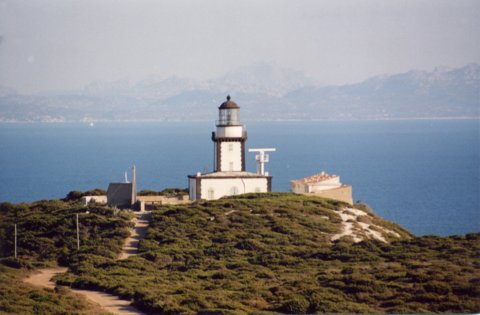|
Capo Pertusato
|
 |
Egidio Ferrighi">Photo(s) © 2002-2005,
|
History: Bonifacio has a stunning setting, situated at Corsica's southernmost point on a narrow peninsula of dazzling white limestone rock. The citadel's ancient walls and buildings rise seamlessly out of sheer chalk cliffs and offer panoramic views out to sea, and beyond to Sardinia, seven miles (11km) to the south. Below the cliffs, on the landward side of the peninsula, is the lovely natural harbour, home to the buzzing marina that attracts yachts from all over the world. Due to its location Bonifacio has maintained an alternative atmosphere from the rest of Corsica, more Italian than French. The town retains Renaissance features found only here, and its inhabitants have their own dialect based on Ligurian, a legacy of the days when this was practically an independent Genoese colony. A good way to see the area is by boat, but there are also stunning walks along the coastline with sensational views over the town from the Pertusato lighthouse. A couple of miles offshore are the Archipel des Lavezzi, a group of granite islands surrounded by clear turquoise water. There are plenty of activities here also, the Plage de Piantarella is a watersports haven, and the coastline has several splendid golf courses including, at Pointe de Spérone, one of France's most celebrated. Of course the town does have its drawbacks: prices are exorbitant and, in August, the crowds are overwhelming. Despite this the old town is one of the most arresting sights in the Mediterranean, easily transcending all the tourist frippery that surrounds it. There are flights to Bonifacio from Marseille, Nice and Paris. Buses leave regularly from Corsica's larger towns, and boats go to and from Sardinia. The Lighthouse The Giraglia Lighthouse is a rotating light of great power, displaying one white flash every five seconds visible from as far as 30nautical miles away. It was Napolean himself who initiated the programme of laying navigation marks and building lighthouses around the coast ofFrance by organising the "Services des Phares et Balises", just one of many civil engineering initiatives he instigated. It wasn't until 1838 that the service became interested in Corsica. Captain Deloffre on board his steamer La Chimere, was giventhe task of surveying the Corsican coast to determine the best points for building lighthouses. Work began almost straight away to construct five major Corsican lights, the Pertusato, La Revellata, Les Sanguinaires and LaChiappa all of them finished by 1845. The Giraglia wasn't finished until 1848, three years late, the delay caused by the island loca-tion and weather limitations for transporting materials, along with a series of other technical difficulties associated with the project. La Giraglia really was the most impressive project as it had required transportation of all materials by sea from Bastia, landing them on the steep-sided rocky outcrop in all sorts of weather conditions, before moving them to the top of the island on donkey's backs. The construction took 10 years, just two years shorter than the Genoise Tower that had been built in the XVI century,some 300 years earlier. Source:
World Travels Source:
Giraglia Rolex Cup (Download PDF press pack)
|
| HOME |
Lighthouse Videos |
FREE Screensavers |
Games & Puzzles |
|
| Lighthouse Tours | Lighthouse LINKS | Accomodations | FAQ |
Contact Us |
All pages and photos copyright © 1996-2025,
Gary P. Richardson and Anna P. Klein, unless otherwise noted.
No images or content on this site may be copied or reproduced without prior permission.
Visit Anna and Gary's Website at https://www.photosetc.net
Back to Top


